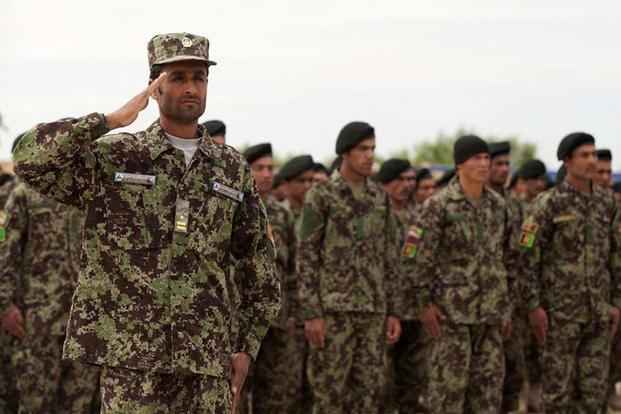The head of U.S. oversight for Afghanistan told lawmakers Tuesday that the Pentagon's wasteful purchase of untested camouflage uniforms for Afghan forces is under criminal investigation.
Testifying before the House Armed Services Committee, John Sopko, special inspector general for Afghanistan Reconstruction, said the Defense Department spent $94 million on a proprietary camouflage pattern -- known as HyperStealth Spec4ce Forest -- for Afghan army forces "without determining the pattern's effectiveness in Afghanistan compared to other available patterns."
The effort resulted in $28 million in excess costs to the U.S. taxpayer and, if unmodified, Sopko said, this procurement "will needlessly cost the taxpayer an additional $72 million over the next 10 years."
Sopko's investigation also found that the Combined Security Transition Command-Afghanistan, or CSTC-A, could not identify the total amount of direct assistance spent on Afghan uniforms -- nor could it account for the total amount of uniforms actually purchased due to poor oversight and poor recordkeeping.
Related content:
- US Overspent by Up to $28 Million on Afghan Army Uniforms: IG
- Mattis Blasts Pentagon for Complacency and Wastefulness
- Military Members Stole Millions in Afghan Rebuilding Effort
"These problems, Madam Chairwoman, are serious. They are so serious that we started a criminal investigation related to the procurement of the [Afghan National Army] uniforms," Sopko told the committee.
As a result of the investigation, he added, "I am going to announce today that we believe it is prudent to review all of CSTC-A's contracts related to the procurement of organizational clothing and individual equipment in Afghanistan."
The investigation's embarrassing findings recently prompted Defense Secretary Jim Mattis to scold the Pentagon bureaucracy, describing the episode as emblematic of an attitude in the Pentagon that allows poor spending decisions to be excused, overlooked or minimized.
Rep. Vicky Hartzler, the Missouri Republican chairwoman for the Oversight and Investigations subcommittee, asked how the forest camouflage pattern was selected over other more economical patterns that are owned by the Defense Department.
Sopko said Afghanistan's minister of defense was never shown any Defense Department-owned camouflage patterns.
"He was basically shown only the patterns owned by one company," Sopko said. "The only options we gave the minister of defense were the proprietary patterns. The bigger problem is no one ever did an assessment as to what type of camouflage is best in Afghanistan.
"Basically, what we were told by CSTC-A, and we are researching this right now, is the minister of defense liked this color, so he picked it," he said.
Peter Velz, director for Afghanistan Resources and Transition for the Office of the Secretary of Defense for Policy, agreed with Sopko's report, saying that a "DoD organization with expertise in military uniforms should conduct an analysis of whether there might be a more cost-effective uniform design and camouflage pattern that meets operational requirements."
"We believe this is the best way to determine the merits of the report's claim that DoD may have spent as much as $28 million over 10 years on uniforms that may be inappropriate for Afghanistan's operational environment," Velz said.
The appropriate Pentagon experts have begun developing a plan for the study, which is expected to begin in the coming weeks, he added.
It's unclear if Velz' office is aware that the U.S. Army conducted an exhaustive camouflage study, which featured an operational evaluation of multiple camouflage patterns -- including HyperStealth, in Afghanistan. The effort resulted in the Army selecting Crye Precision's MultiCam pattern in 2010 as the service's official pattern for Afghanistan.
Since then, the Army has adopted its new Operational Camouflage Pattern, a government-owned pattern that closely resembles MultiCam.
Rep. Seth Moulton, D-Mass., asked what else the subcommittee can do to help prevent these types of mishandled contracts.
Sopko said that holding these types of hearing is important, but so is making sure "tough, hard questions are asked."
"One question you could ask, and I think the full committee should ask, is how many people identified by my office, by the DoD office or by [the Government Accountability Office] have actually lost their jobs because of wasting taxpayers' dollars," Sopko said.
"Send that letter to the Department of Defense ... I bet you no one. We identify these problems; no one is held accountable," he said.
-- Matthew Cox can be reached at matthew.cox@military.com.





























